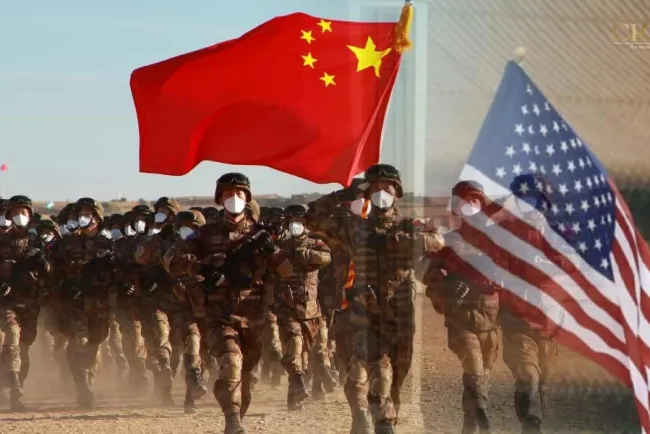Global Trade Tensions Escalate as U.S. Imposes Tariffs on Canada, Mexico, and China
In a significant move that is fueling a global trade war, U.S. President Donald Trump has imposed sweeping tariffs on imports from Mexico, Canada, and China. While the U.S. government argues that these tariffs are necessary for national security and to protect American industry, critics warn that they will lead to higher costs for American consumers and strain relations with key trade partners.

Context & Background:
The U.S. and its trade partners have long had a complicated relationship when it comes to tariffs. Under President Trump, the U.S. has adopted an aggressive trade policy aimed at reducing trade deficits and increasing domestic production. The latest round of tariffs includes a 25% tariff on imports from Mexico and Canada, along with a 10% tariff on Chinese goods. These tariffs are seen as part of Trump’s broader efforts to address issues such as illegal immigration, the flow of fentanyl, and economic imbalances in trade.
Trump has argued that these tariffs will protect American jobs, particularly in industries like automotive manufacturing, energy, and agriculture, by reducing foreign competition. However, economists and business leaders warn that the tariffs could hurt American consumers, raise costs across industries, and disrupt supply chains.
Main Developments:
The tariff measures have sparked immediate retaliation from the affected countries. Canadian Prime Minister Justin Trudeau announced a 25% tariff on $155 billion worth of U.S. goods, including alcohol, clothing, furniture, and electronics. Trudeau emphasized that Canada would not bow to U.S. demands and criticized Trump’s actions as harmful to the long-standing relationship between the two nations.
Similarly, Mexico has implemented its own countermeasures, including tariffs on goods such as vehicles, fresh produce, and electronics. Mexican President Andrés Manuel López Obrador expressed frustration over U.S. interference in Mexican domestic affairs, stressing that the U.S. should focus on collaboration rather than coercion.
In response to the tariffs, China filed a complaint with the World Trade Organization (WTO), warning of further countermeasures. Beijing has stated that it will take steps to protect its economic interests and will continue to challenge the U.S. tariffs on the global stage. The Chinese government also emphasized that it would not be intimidated by the U.S. actions and vowed to retaliate as necessary.
Analysis:
The ongoing trade war between the U.S. and its key allies is beginning to have a ripple effect on global markets. Economists have raised concerns that the tariffs could lead to inflationary pressures in the U.S., with American consumers facing higher prices on goods ranging from food and clothing to electronics and cars. These higher prices could put a strain on household budgets and reduce consumer confidence.
The automotive industry, for example, could be one of the hardest-hit sectors. Tariffs on auto parts from Canada and Mexico could raise the cost of both new and used cars in the U.S., potentially dampening demand and disrupting an already fragile global supply chain. The agricultural sector, too, faces increased pressure as tariffs on Mexican and Canadian agricultural products could lead to higher food prices in the U.S.
Furthermore, the U.S. government has no clear plan for lifting the tariffs, which creates uncertainty for businesses that rely on cross-border trade. The lack of clarity on when or if the tariffs will be lifted makes it difficult for companies to plan for the future, potentially stalling investments and economic growth.
Regional Focus:
In Canada, the tariffs have sparked national outrage. Canadians have rallied around the government’s stance against Trump’s actions, with many boycotting American-made goods in protest. Canadian businesses, particularly in industries like manufacturing and agriculture, are bracing for higher costs and supply chain disruptions as a result of the tariffs. The political fallout is also significant, with Trudeau facing increasing pressure to protect Canada’s economic interests in the face of U.S. trade aggression.
In Mexico, the tariffs have highlighted the strained relationship between the U.S. and its southern neighbor. President López Obrador has called for cooperation but rejected U.S. interference in Mexico’s internal affairs. The tariffs on Mexican goods could disproportionately affect industries like automotive manufacturing, where both countries share a highly integrated supply chain. Mexico’s response, which includes both tariff and non-tariff measures, is designed to shield its economy from U.S. pressure while maintaining trade relations.
In China, the ongoing tariff dispute with the U.S. is part of a broader trade conflict that has already disrupted global supply chains. China has vowed to protect its economic interests and continue its challenge to the U.S. at the WTO. The trade war has already impacted sectors such as technology and agriculture, with both countries engaging in tariff tit-for-tat actions.
Conclusion:
The imposition of tariffs by the U.S. on Mexico, Canada, and China marks a significant escalation in global trade tensions. While President Trump argues that these measures are necessary for national security and to protect American industry, critics warn that the consequences will be felt by consumers, businesses, and economies around the world.
The retaliatory tariffs from Canada, Mexico, and China are likely to further disrupt global supply chains and lead to higher prices for U.S. consumers. As the trade war intensifies, it remains to be seen how long these tariffs will last and whether the U.S. will engage in meaningful talks with its trade partners to resolve the conflict. For now, the global business climate is marked by uncertainty, with many industries bracing for the long-term impact of escalating tariffs.
What's Your Reaction?

















